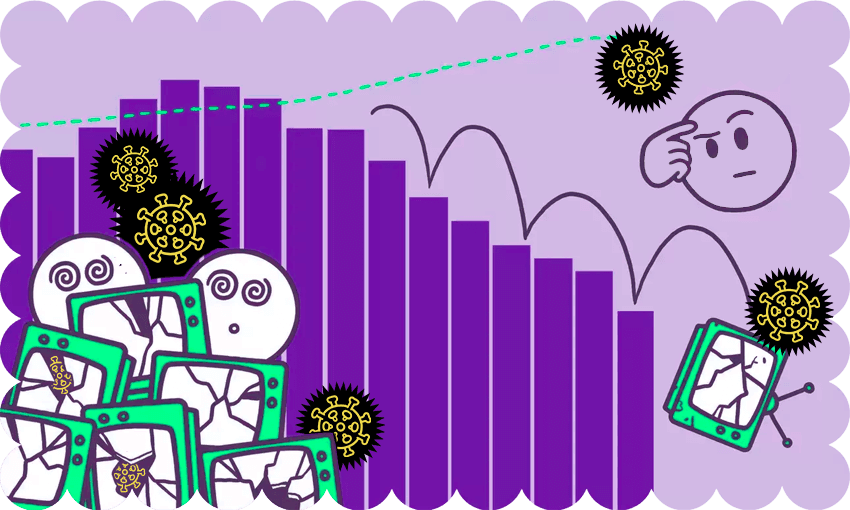What happened to our TV viewership during the most terrifying and transfixing news events of a generation? Duncan Greive reports, with data visualised by Sacha Laird.
Earlier this month I published an analysis of 20 years of ratings data that showed the rise and fall of television as the medium that owned our attention. It was fascinating because it could also be seen as a graph showing the rise of the internet to replace it. The internet has overtaken television as the cultural centre of the majority of our lives, but it’s so much more than that – the place we work, socialise, argue and change norms.
Everyone’s internet is entirely their own, whereas one of the many great things about television’s reign was that its relatively limited number of channels meant it functioned as a kind of social glue, helping us track the same big story, together.
That era seemed definitively over – until the pandemic arrived. Suddenly a lot of us started watching live and linear TV again, and in doing so remembered some of the things we loved about it. The 1pm briefings were life-and-death viewing, but also reminded me of watching X Factor in 2015, when it felt like everyone was on Twitter and watching TV at the same time. There was a weird and cosy nostalgia for the recent-ish past, and a sense of something bigger than what was dividing us instead uniting us, as we stared down the scariest thing we had collectively faced in most of our lifetimes.
Both our major free-to-air networks saw enormous changes in our viewing patterns. “The top rating shows throughout lockdowns over the past two years, across linear and TVNZ+, were 1 News, Breaking News Specials and Seven Sharp,” TVNZ told me in a statement. Discovery, owners of Three, expressed identical sentiments, with a spokesperson saying “Our news bulletins and current affairs shows are where we saw the largest spikes as people tuned in more often… This also drove an increase in viewing from younger demographics, and a significant amount of viewing outside of peak hours.”
You see that in the chart below, which shows PUTS – people using television, on average, between 6am and midnight – month-by-month, starting in January 2019 and running through April 2022. (As I’ll discuss further down, PUTS is no longer the TV industry’s favoured measure, for some valid reasons – but it is what I have, and was widely used for many years.)
You see the normal summer lull, followed by the arrival of Covid-19 prompting a national lockdown and an extraordinary spike, with PUTS moving from less than 500,000 to a peak of over 650,000 in a few short months. In part this was because we were inside and apart from our silly little walks there was nothing else to do apart from work, doom-scroll and watch TV (these were often combined into one terrible hybrid). But it also showed the utility of television – when disaster strikes, you really want it there. The problem is that despite those powerful peaks, that overall trend line still stubbornly drifts downward.

This is even more pronounced when you shift to a different demographic – 18-54, which encompasses most of those of working age and is roughly half our population. You see a similar jump for lockdown one, from 200,000 to 280,000. There’s another precipitous rise when delta arrived last year. But what’s telling there is that the trough had already sunk down to 180,000, and the peak was lower too, at around 235,000 viewers. It shows that even with the pandemic making news and thus television more compelling, the baseline was trending sharply down. For example, June 2020 saw 18-54 at 218,000 – but just a year on it was at 175,000.
That worrying trend was obliterated by delta, which saw Covid-19 enter the community and the ultimate abandonment of the elimination strategy. PUTS shot up to 230,000 as Auckland went into a third lengthy lockdown. But by the time omicron arrived, at the same time as two other major news events in the invasion of Ukraine and the occupation of parliament, it registered as barely a blip. In fact, its peak was lower than any month in 2020, and by April PUTS was down under 150,000 – 50,000 viewers lower than at any point in the last complete pre-pandemic year of 2019.
The next chart is even more dynamic, and ultimately shows what younger New Zealanders did with their attention during the pandemic and the period in which omicron established itself in the community.
The 18-34 cohort is fascinating to me – our youngest adults and thus our best guide to future behaviour. It’s a similar story to the bigger and older group, only more pronounced. There’s still a couple of hard peaks, but the trend line is quite firmly established. The gap between the annual summer trough shows a very pronounced decline – from 54,000 in the summer of 19-20, to 44,000 in 20-21to 35,000 in 21-22, representing a 35% decline in just two summers. Younger people tend to be far more social, especially after enduring long lockdowns, but these are huge chunks out of the audience. By comparison, 5+ only declines from 480,000 to 430,000 over the equivalent period, a little over 10% decline.
This is in part due to the massive and sustained rise of Tiktok as an attention sponge. It has been the most downloaded app in the world three years in a row, and onboards over 500,000 new users every day. Its audience skew young and toward women, and is undeniably impacting consumption of all media forms at this point, with no sign of slowing down. This is in part what made it front-and-centre of TVNZ’s TVNZ+ launch event a couple of weeks back. But as Facebook has shown, traditional media partnerships with social apps tend to last exactly as long as they’re optically useful for the tech companies, and not a minute longer.
What do the TV companies say – and what does it all mean?
The networks obviously have a different way of framing all this, and there is merit in it. Every media form is scrambling to find a new (ideally bigger!) number to emphasise to the advertisers which are its core audience. TV is actually the most credible of all the traditional media platforms, acknowledging a compounding decline in weekly audience reach of around 2% a year over the last decade. This compares to newspaper and magazine readership or radio listenership, which is magically and mysteriously almost always just up a little bit quarter-on-quarter.
TV emphasises reach over PUTS nowadays. What does reach mean? It’s basically the total number of people who saw any linear television over the course of a week. One senior industry source put this number at 3m for 5+, which is both enormous (that’s a lot of people!) and also telling, as it suggests there are now a considerable number of us who never watch TV in any given week. (There are some fish hooks at the margins here – the 3m figure excludes people who might watch TV away from home, like the pub, or stream it through an app).
The reason the reach approach has merit is that advertisers don’t book a single slot, they book a schedule that plays out on different channels over a period of time – so it matters more what the cumulative potential audience is, not the audience at a single moment in time, averaged across the day. But linear TV still occupies a disproportionate share of many budgets and policies, and the fact that around a third of us aren’t there at all says work to address the complexity of evolving audience behaviour should happen with more urgency.
It’s not all bad for linear. One rare bright spot is the growth of live viewing of channels online. While a few years ago the thought was that Netflix style on-demand was the future, one of the major growth areas for TVNZ+ has been from a modern version of a (relatively) ancient behaviour. “What has been really interesting for us over the past few years is the role live streaming our channels plays in our digital strategy,” a TVNZ spokesperson told me in a statement. Still, there is a level of resignation in their overall take on the fate of linear. “It’s no secret linear audiences are declining. TVNZ’s job is to make sure we are growing our online audiences faster than TV audiences decline.”
The pandemic PUTS are a fascinating window into our behaviour change, and what TV remains brilliant at – but also what we lose as it fades further from primacy. One of the many cliches of the pandemic is that it was an accelerator, rushing us into a future which might otherwise have ambled into view more slowly. Within television, it certainly seems to be true, particularly for younger audiences.
The challenging thing for all of us in the media, or those seeking to reach large numbers of people, is that with the often rapid decline in audiences also comes a phenomenal splintering. So that cosy unity which defined the early stage of the pandemic now feels quite distant. Thus the challenge of tying this small nation together grows more complex by the day.
Follow Duncan Greive’s NZ media podcast The Fold on Apple Podcasts, Spotify or your favourite podcast provider.





